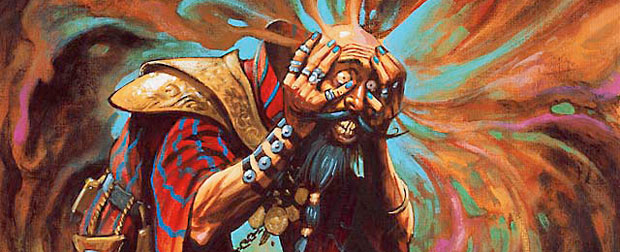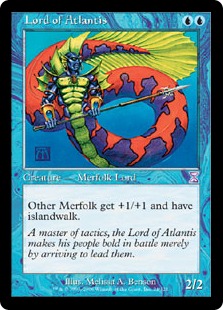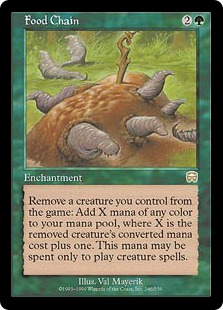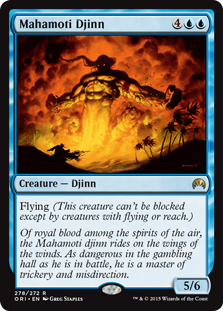By: Derek Madlem
There’s been a lot of comparisons over the years between #mtgfinance and the stock market. Weekly fluctuations have become daily or even hourly fluctuations at this point and some sites even have a crawling price ticker to keep you informed on up to the minute changes in the values of everything.
We look at Magic cards like investors look at corporations. We’re trying to target the most successful cards to acquire just like a stock market investor targets strong companies to acquire stock from. Some cards pay us dividends in the form of improved tournament results while others we target purely on growth potential. We even use the term “blue chip” to refer to longtime strong performers, just like we would in the stock market.
You know what else the stock market has in common with Magic cards? Indexing.
With the stock market, you can theoretically get lucky and pick only winners but that’s rarely the case. Even the best investors have a hard time beating the growth performance of the market average consistently. In stock investing, picking single stocks to go all-in on is a trap. You’ll find very few people without a time machine that would advise you not to diversify. Buying into a little bit of everything spreads out the risk and assures you a steady growth rate over time.
We fancy ourselves savvy investors, but if we’re so savvy why do we constantly fall into the trap of picking individual cards to invest in? For many it’s likely just a knowledge gap, and I’m here to bridge that gap.
I confess that a lot of my success in Magic finance was discovered almost purely by accident. When I was deciding where to park my funds over the years, I didn’t realize what I was actually doing: indexing Magic.
I started out just trying to expand my collection to something operable, I wanted to play formats other than Standard so I first started buying into cheap decks for Extended and Legacy but quickly realized that I didn’t want to limit myself to those budget decks and started acquiring more cards for more decks and eventually more formats. Now I have multiple decks in Standard, Modern, Legacy, Vintage, and Commander…I even have a completely foiled-out cube that features only cards from the two Ravnica blocks, so I’m into a little bit of everything at this point.
Origins
My first Legacy pickups were Wasteland and Aether Vial. Why did I pick these two cards? Because they could be played in two relatively inexpensive decks: Goblins and Merfolk. As I finished these decks I looked to the next decks that I could complete in short order and started picking up dual lands (this was around the time of $75 Underground Seas). As I acquired more cards, more decks became within reach and filling in the gaps became very easy. The side effect of filling in a master list of basically everything playable in each format was that I didn’t miss any of the huge gains. While I could have made a ton of money buying only Force of Wills and dual lands, I would have missed out on all the other increases on cards like Flusterstorm, Stoneforge Mystic, Gamble, City of Traitors, Lion’s Eye Diamond, or Omniscience. Even Modern staples like Serum Visions, Path to Exile, Inquisition of Kozilek, and Kitchen Finks were big winners for me, as most of these were acquired for less than $1.
I even got into Vintage all stars like the Power Nine and Mishra’s Workshop before the double up that the last couple years gave us. At the time I was acquiring them I didn’t have any real ambitions to play Vintage, but figured I should get them “just in case” I was ever interested… and I still haven’t played vintage to this day.
Almost all of these cards appreciated over time. Sure I lost on cards like Standstill and Manabond, but gained just as much on Grove of the Burnwillows and Show and Tells. I owe almost all of my collection’s growth to the simple strategy of owning quality cards over time.
Where to Start
Identifying where to start is pretty easy. The first thing to do is pick which format you want to index. Then you want to break down possible targets into three categories: staples, role players, and everything else. How do you tell them apart?
Staples – these cards show up in a variety of decks in the format and are not dependent on other cards for their power. Great examples include cards like Force of Will, Tarmogoyf, Snapcaster Mage, Liliana of the Veil, and cards of this caliber. You’re never going to have a hard time getting rid of these cards and they’re the most likely to pay dividends as long as you own them.
Role Players – not to be confused with people dressing up and fighting with foam swords in parks or sitting around a table rolling dice while talking in character. Role players are cards that make great decks work, usually by a combined synergy with other role players. The perfect examples for this type of card is Lord of Atlantis. Lord of Atlantis (and his fishy brethren) are typically abysmal on their own but create an extremely powerful force when played within the same deck.
Everything Else – these are cards that are “great in draft” or just have no remarkable or unique abilities. Sure, people may become personal intrigued by these cards, but it’s unlikely that a card like Mahamoti Djinn is ever playable in a constructed format ever again.
Staples
Staples are the cards you see people filling up page after page in their binders, these cards almost always only have on direction to go, it’s just a matter of time. Fetchlands, shocklands, Snapcaster, and Abrupt Decay are great examples of this. These cards will always be needed in just about any deck of the appropriate color for as long as they’re legal… or until a card comes along that outclasses them completely (extremely rare).
The great thing about staples is that they’re subtle and steady, often with small incremental growth that doesn’t even show up on the daily movers pages, allowing them to exist somewhat under the radar. These cards are low risk, pay dividends in increased tournament wins, and don’t spike nearly as hard as other cards unless a major retailer makes a move (like advertising a strong buylist price).
Role Players
These are the cards that only fit into one or two decks but do some serious work within those settings. Our previous example Lord of Atlantis is terrible in Grixis Delver despite being a powerful blue card, but is the bee’s knees in Merfolk thanks to the synergy with all the other fishlords.
Role players can be wild cards from a financial perspective. When an archetype dominates a single weekend, we can sometimes see a strong response in the market, like we did with Tron pieces recently after the deck took first place in both the SCG Open and the SCG Invitational all in the same weekend. When a deck containing Snapcaster Mage gets first place we respond, “of course it did, Snapcaster’s awesome,” but when Oblivion Stone and friends show up in first place we get excited and buy all of the Tron things!
If you’re able to time your buy-ins and cash-outs correctly, you can make some pretty decent money off of these cards. These cards often settle into cycles where they’ll spike and slowly deflate from there. While these cards mostly climb over time, it can take a few spikes to really hold any increase.
Take a look at Food Chain as a great example, this card languished at $3-4 for over a decade. With the printing of Misthollow Griffin in Avacyn Restored we saw a brief uptick but it rapidly deflated until later in March 2014 after putting up a 4th place finish in an SCG Open. The deck’s surprising finish combined with casual demand from Prossh players pushed it up all the way to $19. Since then it’s slowly creeped back down to $16 and will probably continue a ponderously slow downward slide until it hits center stage again.
Everything Else
Simple: don’t buy it. Unless Wizards decides that some day to create a card that that is simultaneously really powerful and says, “If you have a copy of Mahamoti Djinn in your hand, you may discard it to search your library for this card and put it into your hand,” we’re just never going to see Mahamoti Djinn being actually worth money, no matter what some cheeky folks did to manipulate the TCG price.
Indexing for Players
While picking specific winners is hit or miss, acquiring a good mix of staples and role players will yield you great results over time and the easiest way to do that is just acquire all the cards to play as many decks as possible. This gives you a greater access to the game while simultaneously diversifying your “portfolio” across a strong base.
This has the additional advantage of protecting you from risk. Cards like Deathrite Shaman seem like such easy calls to make, the card was so obviously good in basically any deck that could cast it that many players bought in big, buying up dozens or even hundreds of copies; but how much money did all of those players make? Spreading your risk out over a variety of investments lightens the blow when a single investment is affected. If those players had instead bought a cross section of Modern staples and role players instead, they’d be very happy with their investment right now.
Diversification is key when investing, regardless of how you choose to invest. While you might feel like you missed out when you see the guy tweeting pictures of the 500 Sphinx’s Revelations they preordered at $5 each, you’ll feel a lot better when you see the guy tweeting pictures of the 500 Aurelia’s Fury that he preordered at $5 each.
Shameless Self Promotion
I’ll be working in my home town this weekend as a buyer for MythicMTG booth at Gencon then I’ll be hopping on a plane a couple days later to work with the Aether Games crew at Grand Prix San Diego.






Good article Derek, in fact diversification/asset allocation is just about the ONLY thing that matters in stock investing. Timing, stock picking, commissions etc make up about 5-8% of returns historically, asset allocation makes up 90%+. I would disagree with comparing it to indexing because that’s not really diversified, investing in the S&P index is just large cap stocks, it doesn’t include bonds, international, cash, small cap etc which is why over the long haul a diversified portfolio has done better than the S&P because those things limit downside when the market corrects/crashes but your point is a good one overall.
Thanks for clarifying true indexing, I’m no expert at the stock market. Though one could argue that staples and role players are comparable to large cap stocks and that we have ancillary products like Duel Decks, sealed booster boxes, Commander product etc to further diversify a “portfolio” of Magic.
I suspect Fat Moti continues his reign in Old School Magic. I wish they would print that card that allows you to discard him to get something better, though 🙂
I always liked comparing my collection of casual favorites as a magic index fund, love the sentiment of the article, potentially very useful for people new to passive investing.
I was always curious if people speccing in magic maxed their Roth IRAs first…
Also, do you have a list online for that rav block cube? We have one in our playgroup and I’d love to see your take.
cubetutor.com/viewcube/1663